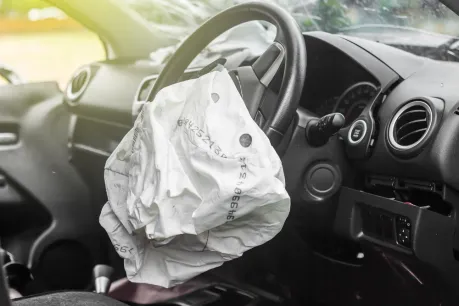When an Airbag Hurts You: What to Do and Your Legal Options

Key Takeaways
- Common injuries from airbag malfunctions include facial fractures, eye damage, spine/neck injuries, burns, and hearing loss.
- After an airbag-related injury, immediately seek medical attention, preserve the airbag and vehicle, and document your injuries and incident details.
- Liability may lie with the vehicle manufacturer, airbag component maker, repair shop, or the driver whose negligence caused the crash and deployment.
- If you were injured by an airbag, contact Morgan & Morgan for a free case evaluation to explore your legal options.
Injured?
Airbags are designed to save lives. Since their introduction, these safety devices have been instrumental in preventing countless fatalities and serious injuries during car accidents.
However, despite their life-saving purpose, airbags can sometimes cause injuries—and in some cases, these injuries can be severe.
Unfortunately, a great deal of these injuries are due to defective airbags that caused more harm than good, and negligent manufacturers failed to properly safety test them or ignored initial reports altogether.
Why Airbags Can Cause Injuries
Airbags are engineered to deploy rapidly during a collision, providing a cushion to reduce the impact on vehicle occupants. However, this rapid deployment, combined with the materials used, can lead to injuries. Common reasons airbags cause harm include:
- Force of Deployment: Airbags inflate at speeds of up to 200 mph, which can cause blunt force trauma.
- Defective Airbags: Manufacturing defects, such as improper inflation or faulty sensors, can lead to malfunctioning airbags.
- Chemical Burns: Airbags deploy using chemicals that can cause burns or skin irritation upon contact.
- Improper Positioning: Being seated too close to the airbag or not wearing a seatbelt can exacerbate the severity of injuries.
- Children and Airbags: Airbags are not designed for young children, and improper seating arrangements can lead to serious injuries for smaller passengers.
Common Airbag Injuries
When airbags malfunction or deploy as intended but with excessive force, injuries can occur. Some of the most common airbag-related injuries include:
- Facial Injuries: Broken bones, bruises, and lacerations.
- Eye Injuries: Corneal abrasions, retinal detachment, or even blindness.
- Neck and Spine Injuries: Whiplash, herniated discs, or fractures.
- Chest Injuries: Rib fractures, sternum injuries, or internal organ damage.
- Burns: Chemical or friction burns caused by the deployment process.
- Hearing Loss: The loud explosion of the airbag deployment can damage hearing.
If you’ve experienced any of these injuries, it’s crucial to seek medical attention immediately and consider the legal steps outlined below.
Steps to Take After an Airbag Injury
If you’ve been injured by an airbag, the actions you take immediately following the incident can significantly impact your health and any potential legal claim. Here’s what to do:
- Seek Medical Attention
- Prioritize your health by seeing a doctor immediately, even if your injuries seem minor. Some injuries, like internal trauma or chemical burns, may not be immediately apparent.
- Keep detailed records of your injuries, treatments, and medical expenses.
- Preserve Evidence
- Take photos of your injuries, the airbag, and any damage to your vehicle.
- Save any clothing or personal items damaged during the airbag deployment.
- If possible, obtain a copy of the police report from the accident.
- Document the Incident
- Write down everything you remember about the accident and the airbag’s deployment. Include details like the speed you were traveling, whether you were wearing a seatbelt, and where you were seated.
- Gather contact information from any witnesses.
- Contact Your Insurance Company
- Notify your insurance company about the accident and your injuries. Be honest and factual, but avoid making speculative statements about fault.
- Contact Morgan & Morgan
- Airbag injury cases can be complex, involving multiple parties such as vehicle manufacturers, airbag manufacturers, and insurance companies. An experienced attorney at Morgan & Morgan can help you navigate the legal process and advocate for fair compensation.
Who Is Liable for Airbag Injuries?
Determining liability in an airbag injury case depends on the circumstances of the accident and the nature of the airbag’s malfunction. Potentially liable parties include:
- Vehicle Manufacturer
- If the airbag’s design or installation was defective, the vehicle manufacturer may be held responsible.
- Airbag Manufacturer
- In cases where the airbag itself is defective, the manufacturer of the airbag may be liable.
- Mechanics or Repair Shops
- If improper maintenance or repairs contributed to the airbag malfunction, the mechanic or repair shop may share liability.
- Another Driver
- If another driver caused the accident that led to your airbag deployment and injuries, they may also bear some responsibility.
Types of Legal Claims
If you’ve been injured by an airbag, you may be entitled to pursue one or more of the following legal claims:
- Product Liability
- Product liability claims focus on defective products. You may have a case if the airbag was defectively designed, manufactured, or marketed.
- Personal Injury
- If another driver’s negligence caused the accident and your injuries, you can file a personal injury claim against them.
- Wrongful Death
- In the tragic event that an airbag injury results in a loved one’s death, family members may pursue a wrongful death claim.
Compensation for Airbag Injuries
Victims of airbag injuries may be entitled to compensation for:
- Medical Expenses: Both immediate and long-term medical costs.
- Lost Wages: Income lost due to time off work for recovery.
- Pain and Suffering: Compensation for physical pain and emotional distress.
- Property Damage: Costs to repair or replace your vehicle and other damaged property.
- Punitive Damages: In cases of extreme negligence or misconduct, courts may award punitive damages to deter future wrongdoing.
Notable Airbag Defect Cases
Some of the most infamous airbag-related lawsuits in recent history highlight the importance of holding manufacturers accountable:
Takata Airbag Recall
The Takata airbag recall is the largest auto recall in U.S. history. The recall involved millions of vehicles worldwide and was linked to at least 19 deaths. This massive recall was due to defective airbags that could explode and release shrapnel. Takata Corporation faced billions of dollars in settlements and penalties.
General Motors Airbag Defect
GM faced lawsuits for airbags that failed to deploy in accidents, resulting in serious injuries and fatalities.
GM vehicles, such as the Silverado, Tahoe, Astro, and Trailblazer, had been manufactured with an issue in their sensing and diagnostic modules, or SDMs, that prevented airbag and seatbelt deployment just 45 milliseconds after a crash begins, creating dangerous and sometimes fatal outcomes in crashes that lasted longer than that minuscule period.
The lawsuit claimed that GM was aware of the defect, concealed it, and failed to issue a recall to avoid the expenses.
These cases underscore the critical role of legal action in ensuring consumer safety and accountability.
How Morgan & Morgan Can Help
If you’ve been injured by an airbag, navigating the legal process can be overwhelming. That’s where Morgan & Morgan comes in. Our experienced attorneys have a proven track record of helping clients secure the compensation they deserve. We offer free case evaluations to get started, and we charge no upfront fees to work with us. The Fee Is Free®, and you only pay if we win your case.
As the largest personal injury law firm with offices in every state across the country, we have the size, resources, and expertise to take on even the largest corporations—including car and airbag manufacturers.
If you or a loved one has been injured by an airbag, don’t wait to take action. The clock is ticking on your ability to file a claim, and evidence can become harder to gather over time. Hiring one of our lawyers is easy, and you can get started in minutes today with a free case evaluation.

We've got your back
Injured?
Not sure what to do next?
We'll guide you through everything you need to know.
